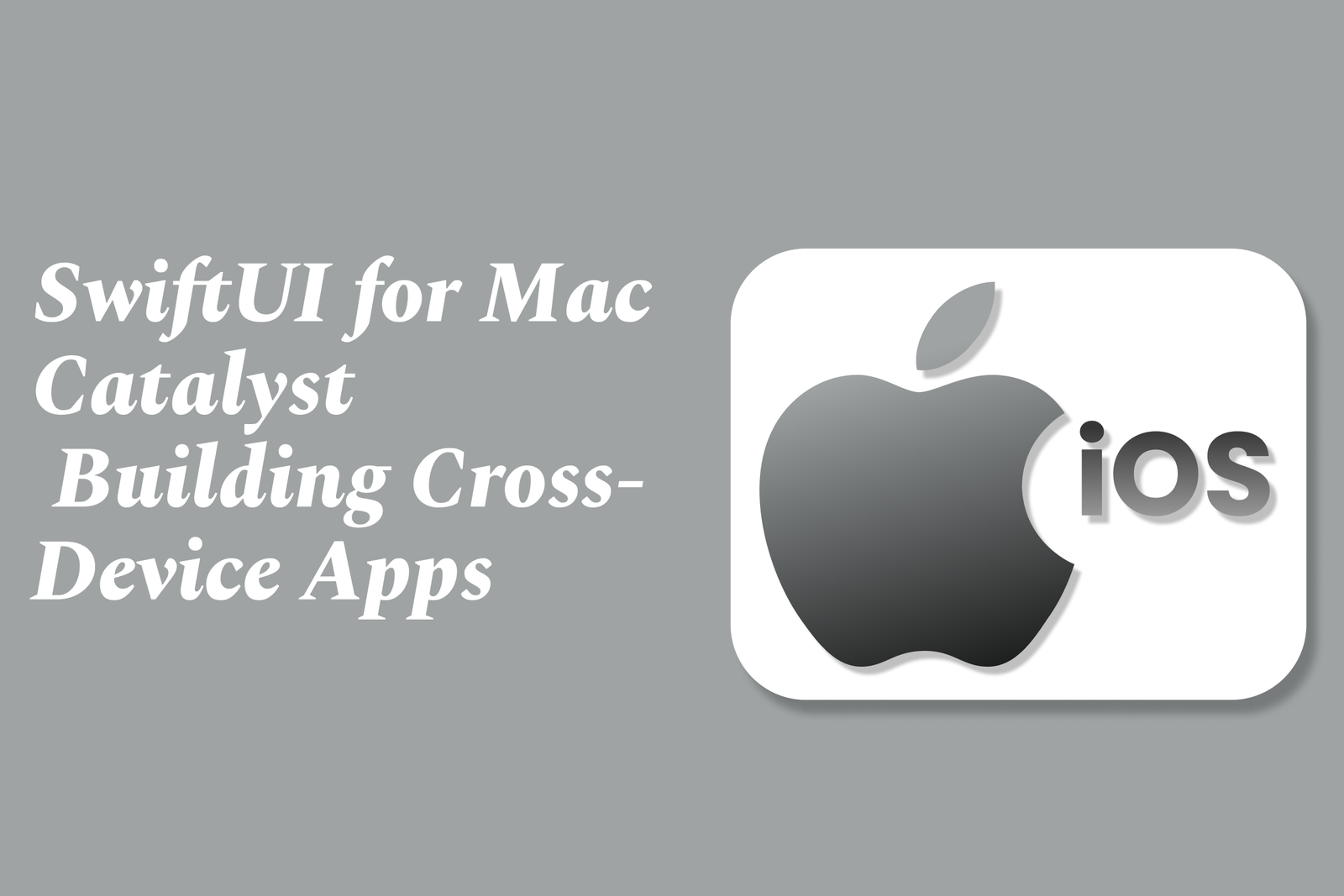SwiftUI for Mac Catalyst: Building cross-device apps
SwiftUI for Mac Catalyst enables developers to build seamless, cross-device apps by using a single SwiftUI codebase that runs on iOS, iPadOS, and macOS. It simplifies UI design, boosts efficiency, and offers native performance across Apple platforms.
SwiftUI for Mac Catalyst: Building Cross Device Apps
1 ) The Shift Towards SwiftUI and Catalyst for macOS Development
Traditional macOS development using AppKit is becoming less prominent, with many developers now focusing on SwiftUI for its modern, cross platform capabilities.
SwiftUI offers a unified approach to building user interfaces that can work seamlessly across iOS, iPadOS, and macOS, often leveraged via Mac Catalyst to port iPad apps to Mac.
Although AppKit remains relevant for highly specialized or performance critical macOS software, SwiftUI and Catalyst represent the future direction encouraged by Apple.
2 ) Advantages of SwiftUI and Catalyst for Cross Device Apps
Cross platform efficiency: Developers can write less platform specific code and maintain a single codebase for multiple Apple devices.
Unified development experience: SwiftUI’s declarative syntax simplifies UI design and state management and allows easier sharing of logic and interfaces.
Apple ecosystem integration: Apps built with SwiftUI and Catalyst naturally leverage native Apple APIs, offering better performance and look and feel fidelity compared to cross platform frameworks like Electron.
3 ) Current Limitations and Challenges
SwiftUI for macOS has limitations in window and lifecycle management, lacking fine grained control over individual windows and some APIs like scenePhase for observing window state.
Some macOS specific APIs and functionalities, especially for non trivial window management or system level operations, are unavailable or harder to implement via Catalyst.
SwiftUI and Catalyst might limit developers if their app requires deep OS integration or highly customized UI behavior exclusive to macOS.
4 ) Performance and Tooling Considerations
SwiftUI apps built with Catalyst compile to native machine code, offering performance comparable or superior to Objective C or UIKit apps.
Despite SwiftUI’s growing maturity, certain advanced use cases or large applications may still face hurdles due to framework instability or feature gaps.
Alternative frameworks like RemObjects Elements currently do not support SwiftUI directly, emphasizing the dominant Apple Swift toolchain for UI development on Apple platforms.
5 ) Community and Industry Perspectives
Developers note a scarcity of macOS specific Swift learning resources, as most tutorials target iOS and general Swift programming.
There is a divided view on whether to focus on native macOS apps or adopt cross platform web/JS based solutions; native apps remain preferred for performance demanding, OS integrated applications.
Many recommend starting cross device Apple app development with SwiftUI and Catalyst for broader reach, switching to AppKit only when advanced macOS features are necessary.
6 ) Best Practices for Building Cross Device Apps with SwiftUI & Catalyst
Begin with SwiftUI for UI code shared across iOS, iPadOS, and macOS, using conditional compilation (#if os(macOS)) to handle platform specific tweaks.
Use Mac Catalyst to port iPad apps to macOS when targeting a broader device base without completely separate UI codebases.
Supplement SwiftUI with AppKit APIs via bridging if advanced macOS only features or window management are needed.
Stay updated with SwiftUI releases, as Apple continuously improves its macOS capabilities and ecosystem support.
Summary:
SwiftUI combined with Mac Catalyst presents a powerful framework for building modern, cross device Apple apps with streamlined development and native performance. While some macOS specific challenges remain, this approach reflects the evolving best practice endorsed by Apple and growing developer adoption, especially for those aiming for code reuse between iOS and macOS platforms.
https://justacademy.in/news-detail/flutter-vs-ionic-2025-performance
https://justacademy.in/news-detail/react-native?s-upcoming-features:-what-to-watch-for
https://justacademy.in/news-detail/android-input-method-editors-updates
https://justacademy.in/news-detail/ios-19-dark-mode-improvements-and-design-tips
https://justacademy.in/news-detail/react-native-expo-sdk-roadmap-for-2025
Related Posts
Java supports GDPR and data privacy by enabling secure data handling through encryption, controlled access, and precise data management. It allows developers to minimize PII exposure, ensure data confidentiality, and design workflows that comply with data protection regulations effectively.
Java code quality tools have evolved to include advanced static analysis, integrated security checks, and AI-powered code reviews. These updates help developers detect bugs, enforce coding standards, and enhance security, streamlining the development process and improving overall code reliability.
Java remains a cornerstone in big tech companies, evolving with modern features like records, pattern matching, and virtual threads. Its robust ecosystem, enhanced performance, and growing AI integrations keep it vital for both legacy systems and innovative new projects.
Java and CI/CD pipeline optimizations streamline Java application development by automating builds, tests, and deployments. They improve efficiency through parallelization, caching, and secure secrets management, enabling faster feedback loops and more reliable, scalable software delivery.
Java supports modern cryptography standards through its flexible Java Cryptography Architecture (JCA), enabling integration of advanced algorithms like AES, EdDSA, and post-quantum tools. Libraries like Bouncy Castle offer FIPS-certified, hardware-accelerated implementations for secure development.
Java 23 enhances record patterns by enabling concise, direct destructuring of record components within pattern matching, simplifying type checks and data extraction. This improvement boosts code readability and expressiveness by reducing boilerplate in handling immutable data classes.
Java remains a top choice for mobile app backends, powering scalable, secure, and high-performance server-side solutions. Latest trends include cloud-native microservices, reactive programming, and enhanced JVM optimizations, enabling efficient, flexible, and robust mobile backend development.
Java SE 24 and LTS Java SE 21 offer enhanced features and performance, while Apache Spark 4.0.0 introduces Scala 2.13 support and advanced ML and SQL capabilities. Together, they empower developers to build scalable, high-performance data applications with modern tools.
JUnit 5 modernizes Java testing with a modular architecture, improved assertions, and seamless Java 8+ support. Beyond JUnit, tools like Mockito and AssertJ enhance mocking and assertions, creating a powerful, flexible ecosystem for writing clean, efficient Java unit tests.
Java plays a pivotal role in cloud automation tools by providing a robust, platform-independent language used to build scalable automation frameworks like Jenkins and Selenium, enabling efficient CI/CD pipelines, testing, and orchestration across diverse cloud environments.










